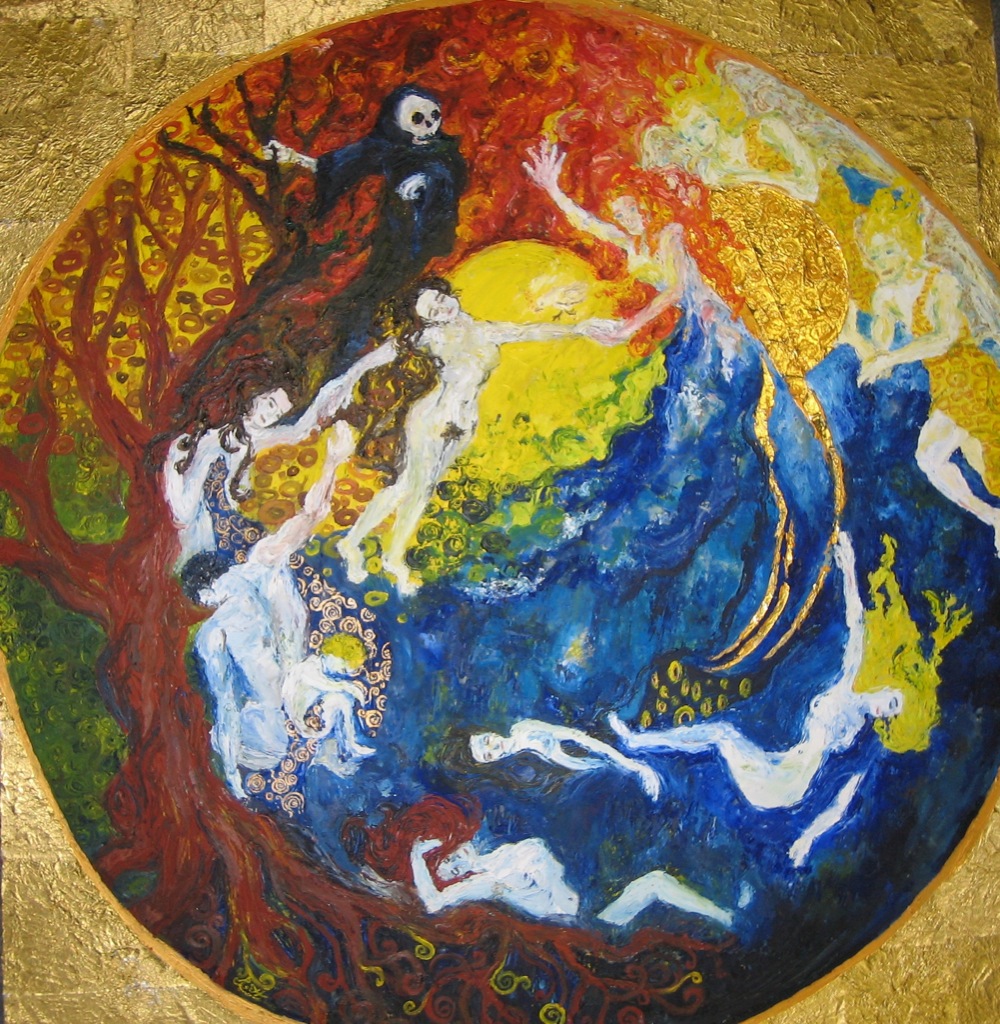We Do Not Yet See Clearly But Hope is Gold
There are people floating in the pool where the stream of living water flows, and they are at peace. I wonder if they have died, and know that there is something afterwards where there will be no death, no sickness.
The last thing that I painted was the skeleton in the cloak, and the angels. The angels give me strength, they watch our lives, they ward off that which comes to devour us.
Once I had finished the rather dreamy process of creating this picture, scrubbed myself with white spirits and returned to normal life, I did not feel I had to be like the family of the dying woman, shown in utter despair on the left side of the painting by the tree. I am lifted up, I can meet people there, in that place of hope, if I am not afraid to give of myself, and realise there is more to Medicine than fighting physical death. I found hope myself in painting it, and the title, I decided afterwards.
Michele Petrone died since I did my painting. I am very grateful for the hope that he inspired.

I enjoyed listening to you at the recent OOOH! meeting in Bristol. As I told you then, this is a wonderful icon that is alchemical and mystical…you have given this doctor hope and I am deeply grateful. Cherish your dreams and paint some more Rachel. It may be more important than you yet know, even!
I picked this artwork due to the use of colours and the composition shown in it. The calm waters with the possibly dead floating serenely, death flying above while the sun burns in the background, and the trees hug the edge of the painting. The serenity and cycical nature of living and dying is portrayed fascinatingly, and evokes the image of yin and yang, while showing the world in all its beauty.
This artwork has a beautiful name, which encompasses what life holds for us, it’s a path that is unlit yet potefull of fortune. Painting in a circle seemingly evokes the concept of the ‘circle of life’ – we are born, we live, we die, and maybe we are reborn, but we start and end as nothing nonetheless. In spite of this, we live as the passage of time passes us by, reflected with the range of seasons being beautifully painted. The woman representing the artist is floating in a sea watching other spirits, maybe they are living or not. This ambiguity as well as with death floating around in the periphery portrays death to be liminal for some, especially those who may be in palliative care, however due to its presence in the periphery alludes to the potential idea of allowing people to live, and have their wishes heard and respected no matter what stage they are in life.
This captures such a beautiful way of looking at life, and indeed healthcare. It’s a poignant reminder that “fighting death” is not the goal of medicine and of healthcare. The artwork is beautiful in itself, but the title of it so effectively captures the human condition and how the only certainty is death, but is itself such a mystery. I like how death is portrayed as the ultimate serenity, as an element of the circle of life which is as natural and as peaceful as living.
I picked this piece because I wanted to find something I could connect with and I have looked through numerous pieces. (Stunning in their own unique way.) But I wanted to find something that didn’t accidently focus on pity towards the patient or diagnoses explored (accidental or otherwise) but especially if present, then purposeful. I feel like this really balances the empathy towards the patient you spoke with and also visually moves beyond this – to represent both their constant balancing and your role in the discussion, as you say, medicine is more than avoiding physical death but in being able to recognise where people are at and meeting them there.
It has made me question why I have spent the week specifically looking for a piece that didn’t focus on pity to respond to. Why this was important to me and why the pieces which do (and there is absolutely nothing wrong with that) but why they made me more uncomfortable or rather, reluctant to engage with. If I had to pin it down right now I’d probably say, as a medic with a lifelong health condition pity has been incrementally woven into the magnitude of the tally that has built over the 25 years of my life, has become inadvertently (and unconsciously?) offensive; it is different from empathy and I think I was surprised to see the surprise embed in some other work. Which expressed shock at the realisation of the “fight” that comes with lived experience, but in equal measure, then could not see the pity written into the creation of the same pieces. Offensive because the “fight” really is just that. It feels strange that something so nuanced and complex and downright difficult can go unseen until intentionally delved into.
There is a balance here, in this piece, which I think you have explored beautifully in finding the hope instead. It is refreshing and heart-breaking in its fragility, to instead explore the hope of it all. The artist part of me, also really appreciates your approach to this – in painting/creating out of response and analysing later, rather than waiting for a specific idea to tackle. It’s also shown me that I have some unconscious bias within my own beliefs of where pity and hope, though opposites almost, can co-exist when necessary, unconscious before finding your piece – so thank you. Here’s to meeting people where they are.